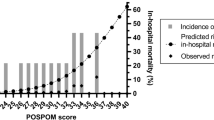Abstract
Purpose
Patients undergoing major emergency abdominal surgery have a high mortality rate. Preoperative risk prediction tools of in-hospital mortality could assist clinical identification of patients at increased risk and thereby aid clinical decision-making and postoperative pathways. The aim of this study was to validate the preoperative score to predict mortality (POSPOM) in a population of patients undergoing major emergency abdominal surgery.
Methods
POSPOM was investigated in a retrospectively collected cohort of patients undergoing major emergency abdominal surgery at a Danish University Hospital from 2010 to 2016. Predicted in-hospital mortality by POSPOM was compared to observed in-hospital mortality. Calibration was assessed by Hosmer–Lemeshow goodness-of-fit and calibration plot. Discrimination was assessed by area under the receiver operating characteristic curve and accuracy was assessed with Brier score.
Results
The study included 979 patients (513 females) with a median age of 64 (IQR 55–77) years. The majority of patients underwent open surgery (94.5%). The observed in-hospital mortality rate was 10.9%. The estimated mean in-hospital mortality rate by POSPOM was 6.7%. POSPOM showed a good discrimination [AUC 0.82 (95% CI 0.78–0.85)] and an excellent accuracy [Brier score 0.09 (95% CI 0.07–0.10)]. However, a poor calibration was found (p < 0.01) as POSPOM underestimated in-hospital mortality.
Conclusions
POSPOM is not an ideal prediction model for in-hospital mortality in patients undergoing major emergency abdominal surgery due a poor calibration.



Similar content being viewed by others
References
Huddart S, Peden C, Quiney N. Emergency major abdominal surgery—“The times they are a-changing”. Colorectal Dis. 2013;15:645–9.
Awad S, Herrod PJJ, Palmer R, Carty HM, Abercrombie JF, Brooks A, et al. One-and two-year outcomes and predictors of mortality following emergency laparotomy: a consecutive series from a united kingdom teaching hospital. World J Surg. 2012;36:2060–7.
Clarke A, Murdoch H, Thomas MJ, Cook TM, Peden CJ. Mortality and postoperative care after emergency laparotomy. Eur J Anaesthesiol. 2011;28:16–9.
Mamidanna R, Eid-Arimoku L, Almoudaris AM, Burns EM, Bottle A, Aylin P, et al. Poor 1-year survival in elderly patients undergoing nonelective colorectal resection. Dis Colon Rectum. 2012;55:788–96.
Saunders DI, Murray D, Pichel AC, Varley S, Peden CJ. Variations in mortality after emergency laparotomy: the first report of the UK emergency laparotomy network. Br J Anaesth. 2012;109:368–75.
Symons NRA, Moorthy K, Almoudaris AM, Bottle A, Aylin P, Vincent CA, et al. Mortality in high-risk emergency general surgical admissions. Br J Surg. 2013;100:1318–25.
Vester-Andersen M, Lundstrom LH, Moller MH, Waldau T, Rosenberg J, Moller AM. Mortality and postoperative care pathways after emergency gastrointestinal surgery in 2904 patients: a population-based cohort study. Br J Anaesth. 2014;112:860–70.
Le Manach Y, Collins G, Rodseth R, Le Bihan-Benjamin C, Biccard B, Riou B, et al. Preoperative score to predict postoperative mortality (POSPOM): derivation and validation. Anesthesiology. 2016;124:570–9.
Collins GS, Reitsma JB, Altman DG, Moons KGM. Transparent reporting of a multivariable prediction model for individual prognosis or diagnosis (TRIPOD): the TRIPOD statement. Eur Urol. 2015;67:1142–51.
Froehner M, Koch R, Hubler M, Heberling U, Novotny V, Zastrow S, et al. Validation of the preoperative score to predict postoperative mortality in patients undergoing radical cystectomy. Eur Urol Focus. 2017;31:31.
Pearse RM, Harrison DA, James P, Watson D, Hinds C, Rhodes A, et al. Identification and characterisation of the high-risk surgical population in the United Kingdom. Crit Care. 2006;10:R81.
McCoy CC, Englum BR, Keenan JE, Vaslef SN, Shapiro ML, Scarborough JE. Impact of specific postoperative complications on the outcomes of emergency general surgery patients. J Trauma Acute Care Surg. 2015;78:912–9.
Gawande AA, Kwaan MR, Regenbogen SE, Lipsitz SA, Zinner MJ. An apgar score for surgery. J Am Coll Surg. 2007;204:201–8.
Whiteley MS, Prytherch DR, Higgins B, Weaver PC, Prout WG. An evaluation of the POSSUM surgical scoring system. Br J Surg. 1996;83:812–5.
Kenig J, Mastalerz K, Lukasiewicz K, Mitus-Kenig M, Skorus U. The surgical apgar score predicts outcomes of emergency abdominal surgeries both in fit and frail older patients. Arch Gerontol Geriatr. 2018;76:54–9.
Cihoric M, Toft Tengberg L, Bay-Nielsen M, Bang FN. Prediction of outcome after emergency high-risk intra-abdominal surgery using the surgical apgar score. Anesth Analg. 2016;123:1516–21.
Kumar P, Rodrigues GS. Comparison of POSSUM and P-POSSUM for risk-adjusted audit of patients undergoing emergency laparotomy. Ulus Travma ve Acil Cerrahi Derg. 2009;15:19–22.
Oliver CM, Walker E, Giannaris S, Grocott MPW, Moonesinghe SR. Risk assessment tools validated for patients undergoing emergency laparotomy: a systematic review. Br J Anaesth. 2015;115:849–60.
Acknowledgements
No funding was received for this article.
Author information
Authors and Affiliations
Corresponding author
Ethics declarations
Conflict of interest
Simon Juul declares no conflict of interest. Dunja Kokotovic declares no conflict of interest. Thea Helene Degett declares no conflicts of interest. Jakob Ohm Oreskov declares no conflicts of interest. Sarah Ekeløf declares no conflicts of interest. Ismail Gögenur declares no conflicts of interest. Jakob Burcharth declares no conflicts of interest.
Appendix
Rights and permissions
About this article
Cite this article
Juul, S., Kokotovic, D., Degett, T.H. et al. Validation of the preoperative score to predict postoperative mortality (POSPOM) in patients undergoing major emergency abdominal surgery. Eur J Trauma Emerg Surg 47, 1721–1727 (2021). https://doi.org/10.1007/s00068-019-01153-x
Received:
Accepted:
Published:
Issue Date:
DOI: https://doi.org/10.1007/s00068-019-01153-x




